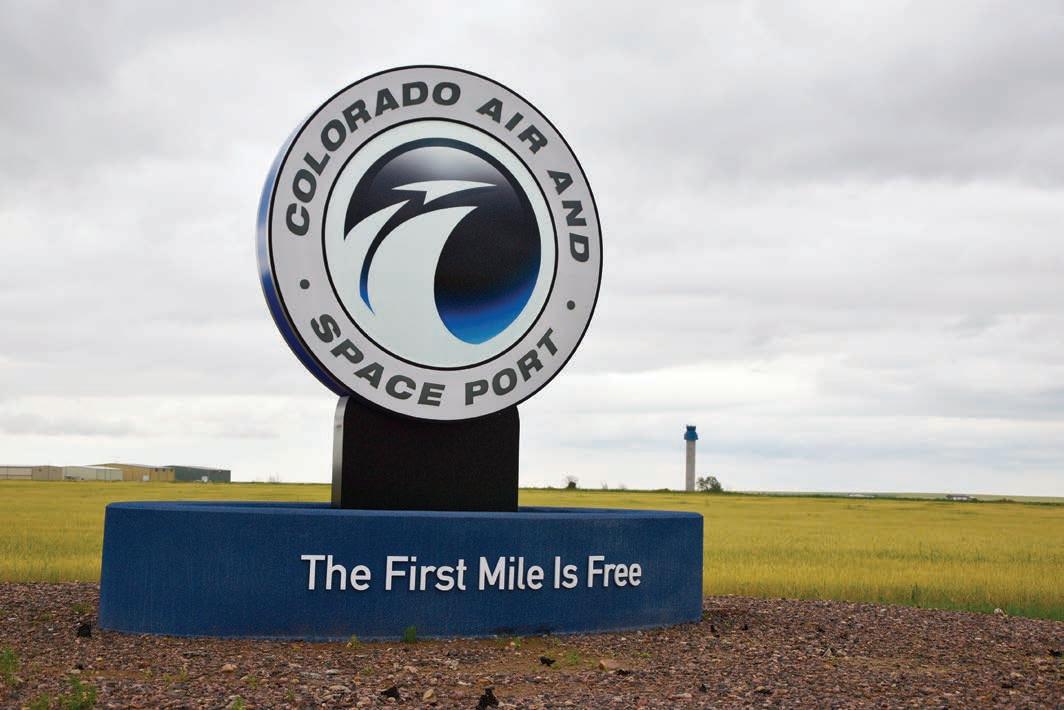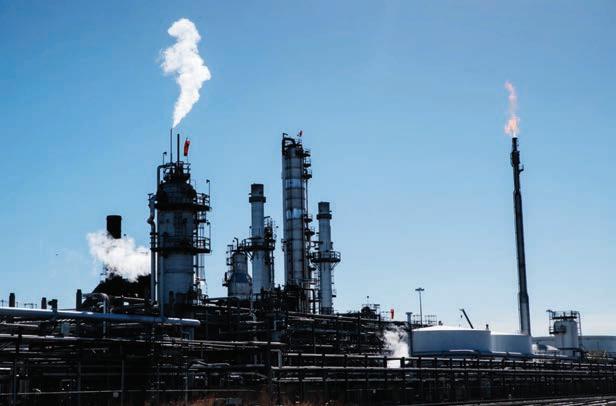
6 minute read
Spaceport continues upgrades for the future of passenger space travel
BY BELEN WARD BWARD@COLORADOCOMMUNITYMEDIA.COM
Expect to see extensive capital upgrades around Colorado Air and Spaceport as it works to bring in new operators and continue with its expansion.
e spaceport will install a fence around the airport perimeter with a control access gate and security cameras. at will be designed to prevent wildlife crossings that interfere with air operations and provide a secure air eld for new operators that did not use the airport due to insu cient security of the air elds and wildlife crossings.
“With anticipation, I would say by the end of the year, we’re planning for the fence and the security project to be completed,” Je Kloska, Colorado Air and Spaceport Director, said.
One of the runaways was recently upgraded by applying a fog seal material to limit deterioration and repainting markings for identi cation on the ground and from the air on runway 17/35, which runs north and south on the east side of the airport.
e plan for the future is a larger project to mill over the runaway, which would grind down the top layer and pave a new layer.
According to o cials, that work should cost about $300,000, paid by grant-funded partnership with the State of Colorado Aeronautics Division. e state would provide $270,000, with Adams County, which owns and operates the spaceport, paying $30,000.
Spaceport is born
Adams County Front Range Airport in Watkins began its approved spaceport site operation license through the Federal Aviation Ad- ministration for commercial space in August 2018. e Colorado Air and Spaceport in Adams County is a horizontal launch and reentry site for public and private travels into space.
It changed its name from Front Range Airport to Colorado Air and Spaceport with plans to change the face of passenger air travel with spaceplanes. Currently, there is 13 FAA licensed spaceport in the United States.
O cials say spaceplanes could one day y up to 34,000 feet outside the Earth’s atmosphere, spending about four to eight minutes at their highest ponts. As the Earth rotates, the space plane will y back down and could land in Paris or Europe within 90 minutes.
Reaction Engines, a company based in the United Kingdom, is working at a Colorado Air and Space facility to develop the Sabre engine, a hypersonic engine design.
“Once they develop the engine, they want to build the airframe and an aircraft around it,” Kloska said. “It is an eventual hypersonic ight point-to-point travel into suborbital ight with potential for low Earth orbit with satellite delivery into orbit.”
Funding is one of the biggest challenges for the 13 spaceports. U.S. Senators John Hickenlooper, John Cornyn, Ben Ray Lujan, and Roger Wicker introduced a bipartisan bill in June to focus on developing commercial spaceports through the Federal Aviation Administration FAA and Spaceport Transportation Infrastructure matching grant program.
Kloska said they have been working with their congressional delegation and several groups who support and aligned with commercial spaceports, such as the global spaceport alliance and legislative folks.
“Commercial space has been growing signi cantly in the last couple of years and will continue to grow and to be able to sustain the signi cant future growth in the United States.
“As a country, we need to start looking at increasing its spaceport capabilities. It’s why the bill is introduced to fund commercial spaceports,” Kloska said.
Kloska said the primary intent and could be wrong is to add the FAA reauthorization bill. ey would be happy either way or whether it’s a standalone bill.
“It makes the most sense to be part of the reauthorization bill because its aerospace and spaces go hand in hand with what FAA does-aviation, and they do base licensing,” Kloska said. e FAA reauthorization bill instructs the FAA to promote U.S. aerospace-related standards globally. It allows the agency to work with foreign partners to simplify the certi cation process for U.S. aircraft. e spaceport is lucky to operate an established airport where some new spaceports must develop the area and focus on just aerospace.

“We are excited to see that, and as things move forward with the current spaceports and armed forces as the country as a whole it needs safe, reliable access to space,” Kloska said.
Kloska said we are in a golden age of space travel, similar to the 60s when John F. Kennedy said we were going to the moon.
“We went to the moon it was all done-we beat the Russians to itmaking that achievement, but once we got there- we stopped going,” Kloska said.
Kloska said we nally realized that the next logical step is establishing a base on the moon and then looking at Mars.
“Getting out of our immediate area of the Earth and the Moon here- is important-you know- going into the future,” Kloska said.
“We want to be a dual aviation and aerospace facility. Also, we want to support and be a major reliever airport for the Denver area for recreation and business aircraft and, relieve all that general arrival delay tra c from Denver International and on the other hand have all the aerospace tra c so that’s our vision for the future,” Kloska said.
“EPA will continue to work with Colorado to secure the re nery’s compliance with laws and regulations and protect the health of nearby residents,” Becker said.
Representatives of the environmental groups welcomed the new scrutiny on Suncor, which has been releasing excessive levels of dangerous materials like benzene, PFAS “forever chemicals,” sulfur dioxide and more into the air and water of south Adams County and north Denver. ey have demanded intensied state scrutiny of the re nery as it seeks permit renewals, and some have called for the outright closure of the sprawling plant, the only petroleum re nery in Colorado.
“We’re grateful the EPA is taking the concerns of community and community-based organizations seriously, but nes aren’t working with these people,” said Ean Tafoya, director of the nonpro t Colorado GreenLatinos, one of the petitioners. “We’ve said for a very long time Suncor continues to be out of compliance, and enforcement isn’t enough, they just keep paying to play. It’s time for us to begin planning the closure of Suncor.”
“We are happy that the EPA took an important step toward holding Suncor accountable for its toxic air pollution,” said Ian Coghill, senior attorney with Earthjustice. “For too long, impacted communities have su ered at the hands of the re nery and the state has failed to hold it accountable. is must result in the state taking a meaningful look at Suncor’s permitting and nally reining in its pollution.” e EPA’s demands in e ect reset the clock on assessing Suncor’s expired permit, which has been under scrutiny for years. Depending on how much the Colorado Department of Public Health and Environment rewrites the Plant 2 permit, the EPA said, “the revisions may involve additional public notice and comment.” e EPA would have 45 days to review how the state handled EPA objections, then the public would have another 60-day petition period to make new objections. e EPA’s order directs Colorado o cials to “evaluate whether additional operational requirements are needed to assure compliance with carbon monoxide and opacity limits at the plant’s uid catalytic cracking unit. It also directs CDPHE to determine whether previous plant modications were analyzed properly.” e EPA’s 99-page summary of its partial agreements with the petitioners appears to lean toward new standards for Suncor, Tafoya said. Environmental groups want the state to require technology upgrades at Suncor that would prevent leaks, including demands to use the “best available technology.”
Coloradans managed while the entire re nery was shut down for repairs early in 2023 after a re, Tafoya said. “ e local economy survived. We’re grateful we have these tools and the EPA appears to be listening,” he said.
Suncor rst sought to renew the Plant 2 permit in 2010. e state allows some industries to keep operating under expired permits, and says it enforces the requirements of the old permit in the meantime.

State air pollution o cials said they were “closely reviewing” the EPA’s decision to grant parts of the petitions to the permit. “ e division will decide how to proceed after its review of the EPA’s decision and documentation,” said a spokesperson for the Air Pollution Control Division.
Given months of news about benzene, sulfur dioxide and other hazardous material releases, Tafoya said, “GreenLatinos wants to have a meeting with the state about cumulative violations.” e EPA announcement said “one petition was led by Earthjustice on behalf of the Elyria and Swansea Neighborhood Association, Cultivando, Colorado Latino Forum, GreenLatinos, Center for Biological Diversity and Sierra Club. e second petition was led by 350 Colorado.” e 350 Colorado petition was denied, the EPA said, but many of the objections in the petition led by Earthjustice were validated. is story is from e Colorado Sun, a journalist-owned news outlet based in Denver and covering the state. For more, and to support e Colorado Sun, visit coloradosun.com. e Colorado Sun is a partner in the Colorado News Conservancy, owner of Colorado Community Media.
Under the U.S. Clean Air Act, the EPA sets regulations on air pollution limits, and state o cials carry out the permitting, inspection and enforcement on the companies receiving permits.
“EPA is also supporting community-based air monitoring and stateled e orts to investigate and address noncompliance issues associated with air emissions from the Suncor plants,” the EPA o ce said.

LOCAL
Voting district discussion goes round and round







